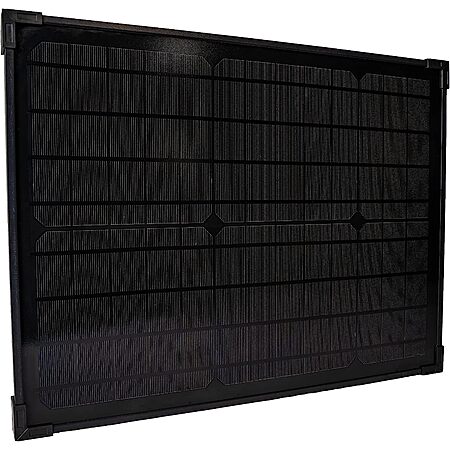Panel technical details:
Quote from madcow3417:
I bought two of these for experimentation. Here's some notes that may help.
Panel specs, per the label:
Max Power Voltage: 6.364V
Max Power Current: 3.174A
Open Circuit Voltage: 8.009V
Short Circuit Current: 4.355A
expiredNEdealseeker posted Jul 07, 2023 01:12 PM
Item 1 of 2
Item 1 of 2
expiredNEdealseeker posted Jul 07, 2023 01:12 PM
Lion Energy GO 20 Portable 20W Solar Panel
+ Free Shipping$8.50
$10
15% offLion Energy
Visit Lion EnergyGood Deal
Bad Deal
Save
Share






Leave a Comment
Top Comments
Panel specs, per the label:
Max Power Voltage: 6.364V
Max Power Current: 3.174A
Open Circuit Voltage: 8.009V
Short Circuit Current: 4.355A
Do not do this! I ripped off the USB port box hoping to re-wire the solar cells from parallel to series or something. The cells are totally fixed, all the board has access to is a single connection point. it was risky and dumb, but I managed to not destroy anything.
The USB ports output 4A @ 5.34V with their own controller, so, good for a phone. The cable with micro-usb plugs is essentially directly connected to the cells. 6.364V is too low to do anything useful with. A direct connection to solar panels must be used with a solar controller, either MPPT or PWM. 95% of controllers require a panel voltage ~2V higher than the device you're charging. The other 5% are boost controllers.
I couldn't find a boost controller that worked as low as 6.34V. I put a hinge between the panels, tying them together physically. I cut off those micro-usb connectors and connected the wires up in series, so the set's max power is now 3.174A @ 12.728V. What I used was called "ZK-SJ20" MPPT boost controller which I purchased from aliexpress but is available elsewhere. I wired it all up, set the input voltage to 12.7V (for max power) and set the output voltage to 42V (to charge 10s batteries). I was charging my lawnmower batteries off $17 worth of panels and $20-$30 worth of charger board.
https://www.amazon.com/gp/product/B01E5V5GMG/
And these are the XT30 connectors I used:
https://www.amazon.com/gp/product/B0875MBLNH/
Don't plug the micro-usb directly into devices, they're connected straight to the cells. Weird things will happen. Modern phones with fancy charge controllers built in will probably connect and disconnect as the current and voltage changes. Other devices might get fried with the 8.0V coming out of the connector. There are 2 USB-A ports that have their own controller. You can safely use USB-A to USB-C or lightning cables with those ports and most devices.
126 Comments
Sign up for a Slickdeals account to remove this ad.
Our community has rated this post as helpful. If you agree, why not thank madcow3417
Panel specs, per the label:
Max Power Voltage: 6.364V
Max Power Current: 3.174A
Open Circuit Voltage: 8.009V
Short Circuit Current: 4.355A
Do not do this! I ripped off the USB port box hoping to re-wire the solar cells from parallel to series or something. The cells are totally fixed, all the board has access to is a single connection point. it was risky and dumb, but I managed to not destroy anything.
The USB ports output 4A @ 5.34V with their own controller, so, good for a phone. The cable with micro-usb plugs is essentially directly connected to the cells. 6.364V is too low to do anything useful with. A direct connection to solar panels must be used with a solar controller, either MPPT or PWM. 95% of controllers require a panel voltage ~2V higher than the device you're charging. The other 5% are boost controllers.
I couldn't find a boost controller that worked as low as 6.34V. I put a hinge between the panels, tying them together physically. I cut off those micro-usb connectors and connected the wires up in series, so the set's max power is now 3.174A @ 12.728V. What I used was called "ZK-SJ20" MPPT boost controller which I purchased from aliexpress but is available elsewhere. I wired it all up, set the input voltage to 12.7V (for max power) and set the output voltage to 42V (to charge 10s batteries). I was charging my lawnmower batteries off $17 worth of panels and $20-$30 worth of charger board.
Attachment 13854908
Panel specs, per the label:
Max Power Voltage: 6.364V
Max Power Current: 3.174A
Open Circuit Voltage: 8.009V
Short Circuit Current: 4.355A
Do not do this! I ripped off the USB port box hoping to re-wire the solar cells from parallel to series or something. The cells are totally fixed, all the board has access to is a single connection point. it was risky and dumb, but I managed to not destroy anything.
The USB ports output 4A @ 5.34V with their own controller, so, good for a phone. The cable with micro-usb plugs is essentially directly connected to the cells. 6.364V is too low to do anything useful with. A direct connection to solar panels must be used with a solar controller, either MPPT or PWM. 95% of controllers require a panel voltage ~2V higher than the device you're charging. The other 5% are boost controllers.
I couldn't find a boost controller that worked as low as 6.34V. I put a hinge between the panels, tying them together physically. I cut off those micro-usb connectors and connected the wires up in series, so the set's max power is now 3.174A @ 12.728V. What I used was called "ZK-SJ20" MPPT boost controller which I purchased from aliexpress but is available elsewhere. I wired it all up, set the input voltage to 12.7V (for max power) and set the output voltage to 42V (to charge 10s batteries). I was charging my lawnmower batteries off $17 worth of panels and $20-$30 worth of charger board.
Attachment 13854908
Any thoughts on how well these solar panels work for charging small portable electronics like phones, etc? At this price, i'm wondering if it's worth getting one for charging a phone or battery pack in case of emergency (even though phones aren't useful for making calls if the local cell towers are without grid-provided power for more than a few days). I see that the end of their charge controller block has 2 Micro-USB B male connectors on it instead of USB female plugs, which is unfortunate since most modern devices use USB-C or lightning connectors and you will have to buy 2 female Micro-USB-B to female USB connectors in order to fully use this on modern electronic devices. Those adapters aren't expensive, but a 2 pack costs about as much as one of these solar panels does, effectively doubling your cost to get up and running.
Our community has rated this post as helpful. If you agree, why not thank sjaxkingpin
Any thoughts on how well these solar panels work for charging small portable electronics like phones, etc? At this price, i'm wondering if it's worth getting one for charging a phone or battery pack in case of emergency (even though phones aren't useful for making calls if the local cell towers are without grid-provided power for more than a few days). I see that the end of their charge controller block has 2 Micro-USB B male connectors on it instead of USB female plugs, which is unfortunate since most modern devices use USB-C or lightning connectors and you will have to buy 2 female Micro-USB-B to female USB connectors in order to fully use this on modern electronic devices. Those adapters aren't expensive, but a 2 pack costs about as much as one of these solar panels does, effectively doubling your cost to get up and running.
Don't plug the micro-usb directly into devices, they're connected straight to the cells. Weird things will happen. Modern phones with fancy charge controllers built in will probably connect and disconnect as the current and voltage changes. Other devices might get fried with the 8.0V coming out of the connector. There are 2 USB-A ports that have their own controller. You can safely use USB-A to USB-C or lightning cables with those ports and most devices.
Sign up for a Slickdeals account to remove this ad.
Panel specs, per the label:
Max Power Voltage: 6.364V
Max Power Current: 3.174A
Open Circuit Voltage: 8.009V
Short Circuit Current: 4.355A
Do not do this! I ripped off the USB port box hoping to re-wire the solar cells from parallel to series or something. The cells are totally fixed, all the board has access to is a single connection point. it was risky and dumb, but I managed to not destroy anything.
The USB ports output 4A @ 5.34V with their own controller, so, good for a phone. The cable with micro-usb plugs is essentially directly connected to the cells. 6.364V is too low to do anything useful with. A direct connection to solar panels must be used with a solar controller, either MPPT or PWM. 95% of controllers require a panel voltage ~2V higher than the device you're charging. The other 5% are boost controllers.
I couldn't find a boost controller that worked as low as 6.34V. I put a hinge between the panels, tying them together physically. I cut off those micro-usb connectors and connected the wires up in series, so the set's max power is now 3.174A @ 12.728V. What I used was called "ZK-SJ20" MPPT boost controller which I purchased from aliexpress but is available elsewhere. I wired it all up, set the input voltage to 12.7V (for max power) and set the output voltage to 42V (to charge 10s batteries). I was charging my lawnmower batteries off $17 worth of panels and $20-$30 worth of charger board.
Attachment 13854908
For a mower, I probably cut the grass once a week, so 4 or 5 days would be fine. Worst case, I just charge them in the house. But having a green option just makes sense.
Sign up for a Slickdeals account to remove this ad.
Leave a Comment